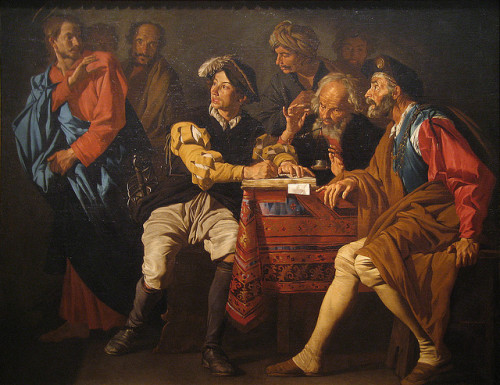 Painting: ‘The Calling of St. Matthew’
Painting: ‘The Calling of St. Matthew’
Artist: Matthias Stomer (1600-1650)
Image Courtesy: Molly/Flickr
(CNA) St. Matthew, the first century ‘Tax Collector’ turned Apostle, chronicled the life and ministry of Christ in his Gospel. While little is known of Sr. Matthew, the account which he wrote about Christ’s Ministry is of inestimable value to Christians, particularly to his verification of Jesus as the Messiah.
The Gospel accounts of St. Mark (Feast Day: 25 April) and St. Luke (Feast Day: 18 October) like St. Matthew’s own, describe the encounter between Jesus and Matthew: Matthew 9:9-13 under the surprising circumstances of Matthew’s tax-collecting duties. Jewish Publicans who collected taxes on behalf of the Roman authorities of first century Judea were objects of scorn, even hatred among their own communities–since they worked on behalf of the occupying authority, often earning their living by collecting more than the state’s due.
Jesus most likely encountered Matthew near the house of St. Peter (Feast Day: 29 June) in Capernaum, near the Sea of Galilee — Matthew’s calling into Jesus’ inner circle, was a dramatic gesture of of the Messiah’s universal message and mission, causing some religious authorities of the Jewish community to ask: “Why does your teacher eat with the tax-collectors and sinners?” —Matthew 9:11 Jesus significant response indicated a central purpose: “For I came not to call the righteous but sinners.” Matthew 9:13; See also: Mark 2:15-17 and Luke 5:29-32
A witness to Christ’s resurrection after death as well as His ascension into Heaven and the events of Pentecost, Matthew also recorded Jesus’ instruction for the Apostles:
“Go therefore and make disciples of all nations, baptizing them in the name of the Father and of the Son and of the Holy Spirit, teaching them to observe all that I have commanded you and Lo, I am with you always, to the close of the age.” — Matthew 28:19-20
Like 11 of the 12 Apostles, St. Matthew is traditionally thought to have died as a Martyr for Christ, while ministering the Gospel.
There is some disagreement as to the place of St. Matthew’s martyrdom according to EWTN and the kind of torture inflicted upon him, therefore its is not known whether St. Matthew was beheaded, burned or stoned to death.
Both St. Matthew and his Gospel have inspired important works of religious art, ranging from the ornate illuminated pages of the ‘Book of Kells’ to the St. Matthew Passion of J.S. Bach — Three famous paints of Caravaggio, depicting St. Matthew’s calling, inspiration and martyrdom, hanging within the Contarelli Chapel in Rome’s Church of St. Louis of the French.
Reflecting on St. Matthew’s calling, from the pursuit of dishonest financial gain to the heights of holiness and divine inspiration, Pope Emeritus Benedict XVI said, “…the persuasive voice of the publican Matthew, who having become an Apostle, continues to proclaim God’s saving mercy to us and let us listen to St. Matthew’s message, meditating upon it ever anew also to learn to stand up and follow Jesus with determination.”
More here from Franciscan Media
Related: For Today’s Holy Scripture Readings on the Feast of St. Matthew, Apostle & Evangelist, Visit: -USCCB
Tweet